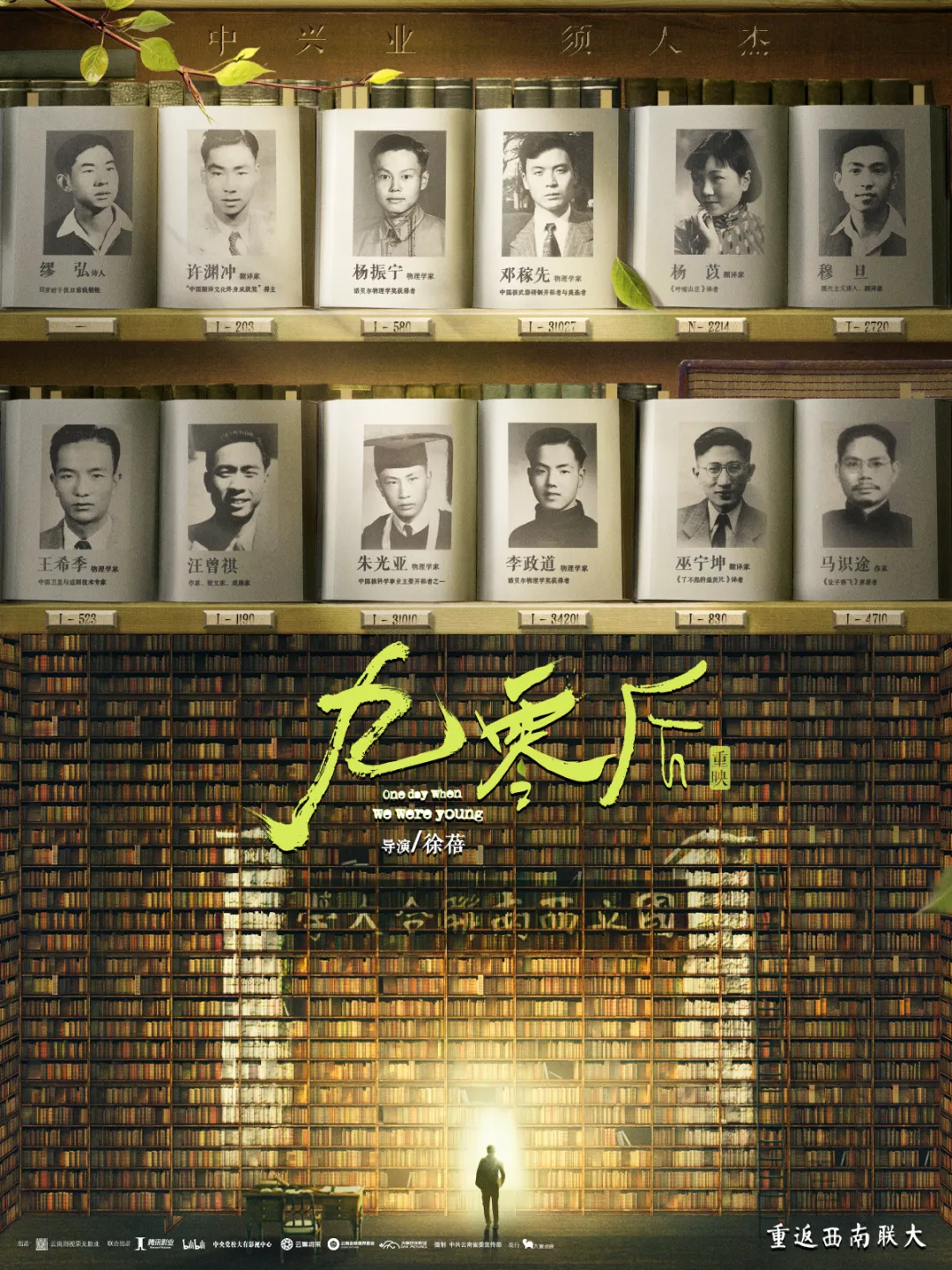
The new film "Thirty Thousand Miles of Chang'an", which was released on July 8, has written an epic of the Tang Dynasty with a time span of 60 years. This is a one-volume collection of photos of Tang Dynasty literati such as Gui Nian and Zhang Xu.
The film creatively takes old age and high fitness as the perspective, and recalls the past with Li Bai in his life, from the prosperity of Kaiyuan to the Anshi Rebellion, from Jiangxia with clear water to Chang'an with narrow and sloping avenues, from Yangzhou with singing and dancing to yellow and white. Cloud's Xisai, a picture scroll of mountains and rivers in the Tang Dynasty unfolds slowly in front of the audience.
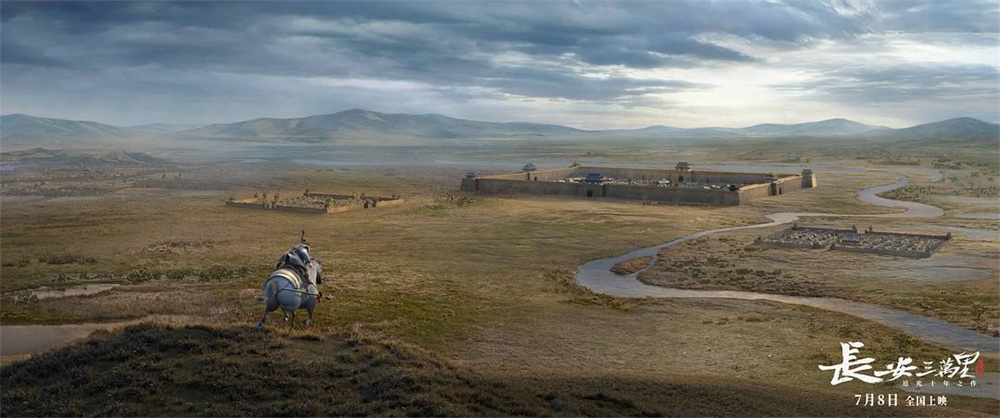
Stills of "Thirty Thousand Miles in Chang'an"
In the process of narration, the visual presentation of famous stories by famous writers brings audiences a wonderful movie-watching experience like a Chinese study class. When faced with those verses that were well memorized in class but were busy taking exams and skipped the true meaning, many people who have left the campus can also appreciate the life situation and philosophical thinking that the poet wanted to express between the lines.

Stills of "Thirty Thousand Miles in Chang'an"
The story of this romantic and sentimental "Poetry Movie" was inspired by director Xie Junwei's real-life experience of taking his second-grade son to recite "129 Ancient Poems that Primary School Students Must Memorize". Once, after his son recited "Chun Mian Unaware of Dawn", Xie Junwei naturally followed up with "I hear birds singing everywhere. The sound of wind and rain at night, how many flowers fall." The child was surprised that his father could also recite the poem "Spring Dawn", In an instant, the two generations of father and son were linked together by the poetry culture, allowing the two to truly feel the resonance of generations due to the poetry culture.
When Song Yiyi, the producer of "Thirty Thousand Miles in Chang'an", started this project, her daughter was only one year old and could recite "Quiet Night Thoughts". "No one has asked her deliberately, but the rhyme of the poems is easy for her to remember. Our generation will read these poems, and our next generation and the next generation will also read them. This is a kind of inheritance. The core lies in the understanding of words. understanding."
"The two generations have reached a connection through culture, which is the transmission of culture." Xie Junwei deeply felt that "history and culture are very three-dimensional. It is not just a certain picture or a certain poem in a textbook. It carries a lot of spirit and Stories, these stories can touch us, and we hope it can touch more people."

Director Xie Junwei
In 2020, the story of "Thirty Thousand Miles of Chang'an" began to be conceived. By the end of that year, the first version of the script was created, and the production of the storyboard began at the end of May 2021. The production was finally completed in June this year. theaters.
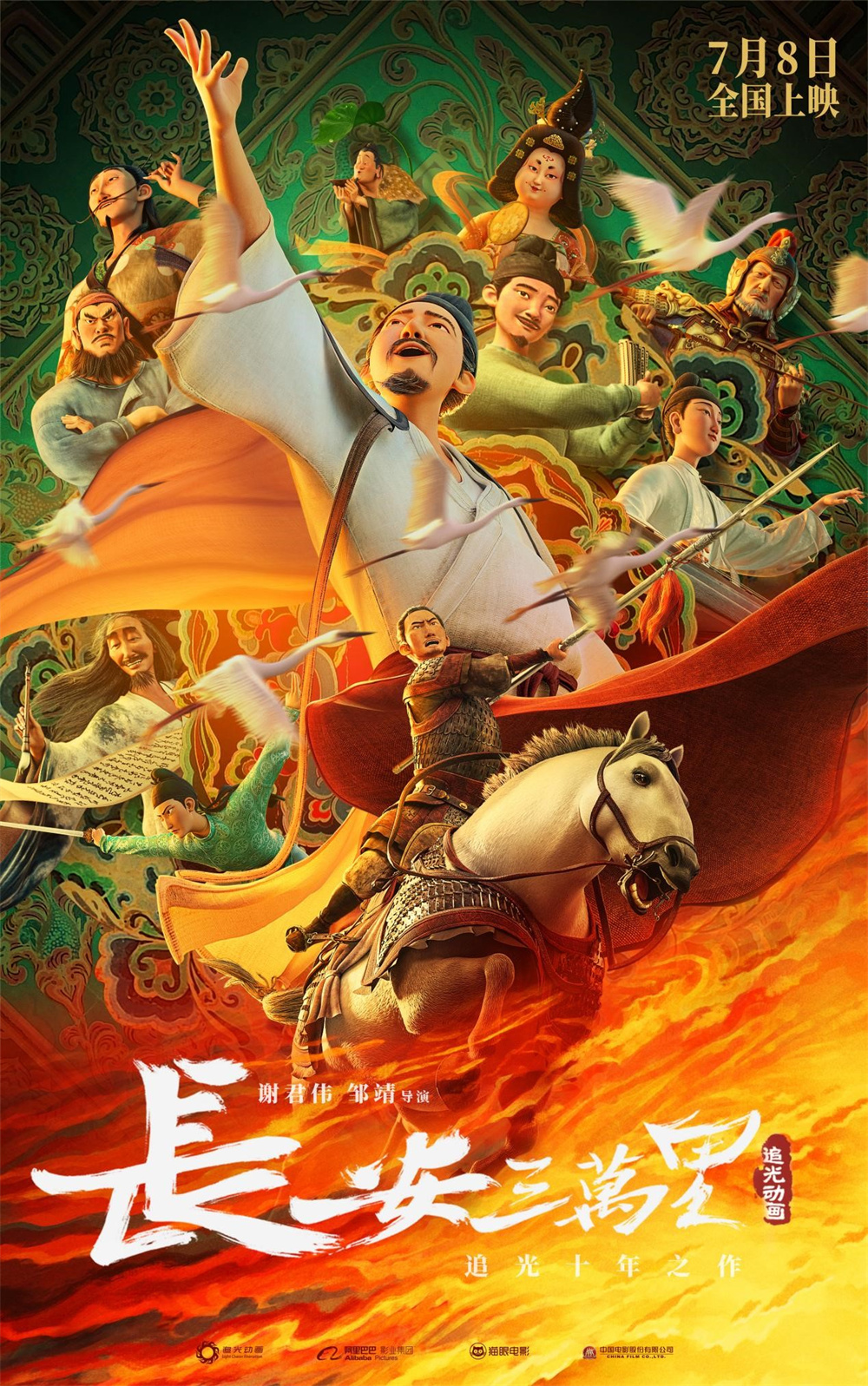
"Thirty Thousand Miles of Chang'an" poster
"Three Thousand Miles of Chang'an" is the beginning of the "New Culture" series of Chasing Light animation. It takes historical figures and classic works as the objects of creation, and uses the form of animated films to show the historical atmosphere. "The third product line after that.
The title of "Thirty Thousand Miles in Chang'an" is taken from a poem by Chen Zilong in the Ming Dynasty - "Dream of Chang'an Thirty Thousand Miles, the sea breeze blows off the west end of the moraine". At the same time, the title of the film actually shows the theme of the film. "Chang'an" represents the "ideal land" in the hearts of poets such as Gao Shi and Li Bai, and "Thirty Thousand Miles" is the distance between them and their ideals.
Xie Junwei, who has been in the animation industry for 16 years and "chased the light" all the way, is the veteran of the light-chasing animation. He once served as the animation director in "White Snake: Origin" and "White Snake 2: The Green Snake". "We hope that through this movie, we can lead the audience back to the era when the stars of the Tang Dynasty were shining. In this era, we can continue to pursue romance and pursue our ideals in life."
Looking at Li Bai's life from the perspective of high fitness, the choice of life is a common theme in ancient and modern times
The beginning of the animation is a few years after the Anshi Rebellion, the Tubo army invaded the southwest, the Tang Dynasty put Gao Shi at a disadvantage in the war, and Chang'an was already in jeopardy. On the eve of the war, the eunuch of the imperial court went to Gao Shi's tent to inquire about Gao Shi and Li Bai's life.
Li Bai and Gao Shi, one is a banished immortal whose talent competes with the sun and the moon, and the other is the only one among the famous poets of Tang Dynasty who has reached the official position. In the lofty sentiments of their later years, the two heroes wandered and wandered in the Tang Dynasty, met talented people, but experienced the catastrophe of Anshi, and looked back at the vicissitudes of their lives in their later years. Although it is recorded in the history books that the two met in middle age, the main creative team began to imagine from a poem written by Du Fu "Drunk Sleeping in Autumn Together, Hand in Hand with the Sun"-they both visited the same area at similar ages, according to These details have been speculated on whether they knew each other when they were young, so they could achieve "autumn co-quilt" in middle age.
The 164-minute ultra-long film shows the history of the ups and downs of the Tang Dynasty and the glory of Tang Dynasty literature and art together. Surprise eggs one after another.
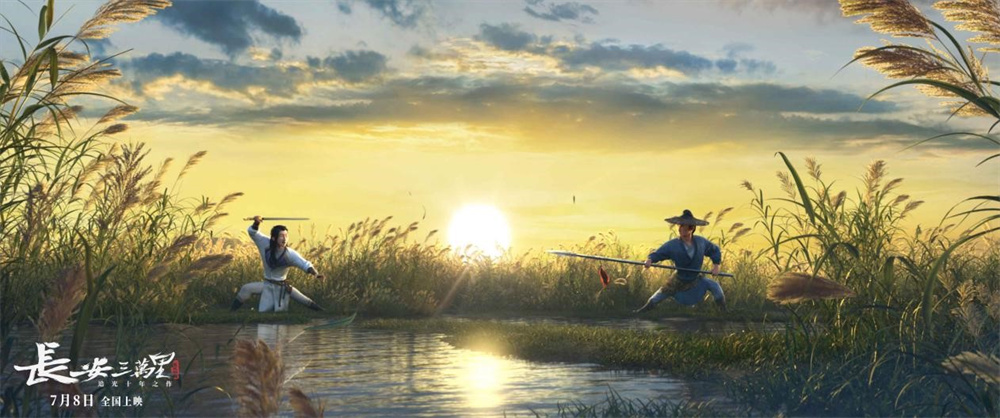
Li Bai (left) and Gao Shi (right)
Different from the unrestrained and free and easy we know in books, "Thirty Thousand Miles of Chang'an" portrays an image of Li Bai who has been trapped in the secular requirements all his life. Even a banished immortal cannot avoid the secular society's expectations and disciplines for people. Constrained by his humble background, Li Bai experienced several twists and turns in the upsurge of literati in the Tang Dynasty, and had no choice but to marry, and was entangled between entering the world and being born. But he had to drink freely, and in his later years, he was on the wrong side of the political struggle and his life was hanging by a thread. Through Gao Shi's memories, the audience can also realize that the life standards and meeting and parting of the ancients are far different from those of today's people. The ten years of life may be spent as if nothing happened, and their life may only be with their confidantes and friends. After meeting a few times, they never met again.
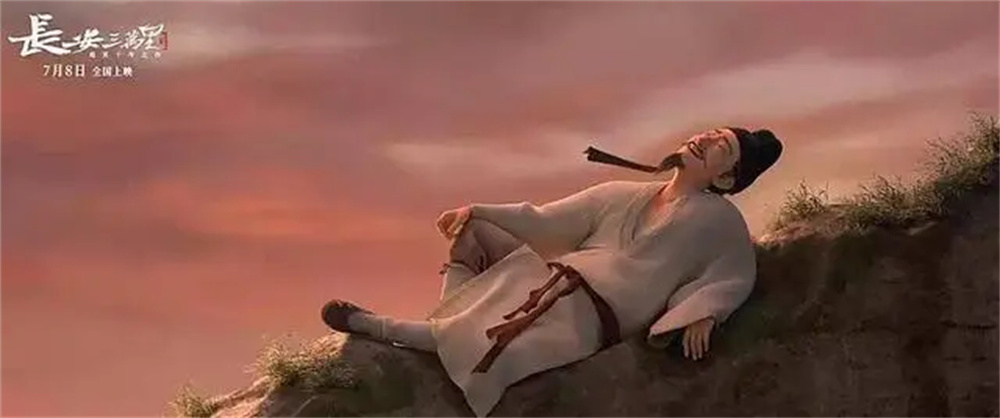
Li Bai's downfall
"The Li Bai that people know today is a genius and a banished immortal, but most of us are ordinary people. Gao Shi is more like an ordinary person in the traditional sense, and he is closer to the public." Therefore, the main creator chose Gao Shi's From the point of view to tell the story.
Whether it is a genius or an ordinary person, in the movie, the audience can see that everyone is not so successful. Li Bai struggled between being born and entering the world all his life, encountering hardships and setbacks. When Gao Shi was young, he also felt that his talent was limited, he was not good at reading, and hit a wall everywhere, and he didn't become a master until his later years. Du Fu's talents were underappreciated, and Guo Ziyi was almost beheaded. Everyone pursued their ideals in their own way in a state of frustration. "This is what we especially want to pass on to everyone. Everyone has their own difficulties in life. Putting the theme of pursuing ideals in the present, facing the changes of the times and technology, how do we deal with ourselves and how do we To look at the relationship between you and your ideal, everyone does it differently, but the choices you make in this life. It talks about something about 'change and invariance', what changes is the torrent of the times, what changes is the passage of time, no What has changed is our proud heart standing between heaven and earth. We can’t tell the audience what to do, but if we can give the audience some inspiration, we will be very happy,” said director Zou Jing.

Director Zou Jing
There are many challenges, repeatedly breaking the record of light chasing animation
Light-following animation has always been praised in terms of production technology. This time, "Three Thousand Miles of Chang'an" has the most versions of characters in different states, the most secondary characters, the most scenes, and the most climate and weather changes in the same scene. one of the works.
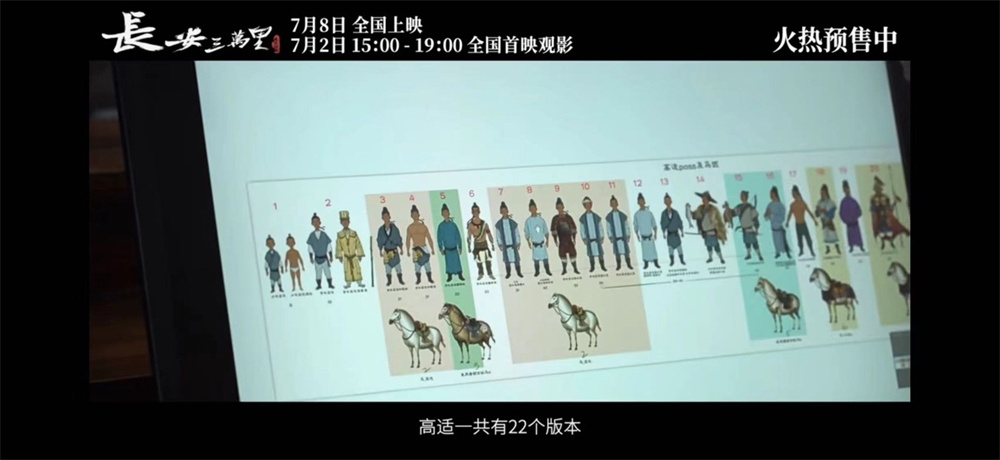

The 22nd version of Gao Shi and the 15th version of Li Bai
In terms of character image design, Gao Shi has 22 versions, while Li Bai has 15 different shapes. Because the time span of the film is particularly large, it involves images of characters of different ages. Take Gao Shi as an example. From the age of 8 to 60, he changed his clothes, grew his beard, and changed his skin texture. He even had many kinds of horses in different periods. In particular, the clothing fabrics of the characters are also very thoughtful. The patterns, textures, and colors are all designed with reference to unearthed cultural relics. In the Tang Dynasty, different clothing colors meant different official ranks. In the movie, Gao Shi was already wearing a purple robe when he was finally promoted to the Jiedushi of the Three Towns.
Li Bai is one of the poets the audience is most familiar with in books, and the middle-aged Li Bai in the movie is closer to the familiar image. As for the young Li Bai, he focused on expressing the chicness of the characters, and Li Bai's outstanding swordsmanship, so he had such an image of a swordsman with loose hair. In the film, both Li Bai and Gao Shi are dressed in the standard round-collar gowns of the Tang Dynasty, but due to their different personalities, there are subtle differences in the design of the costumes. Gao Shi has a tough personality and dresses in a well-regulated manner; Li Bai is relatively chic and comfortable, so his round neck system will have some changes, and the buttons on the neckline are often unbuttoned.
In order to fully restore the style and features of the Tang Dynasty, the crew chose to use the aesthetics of the Tang Dynasty as the benchmark, refer to the proportions and shapes of the characters in Tang figurines, Tang Dynasty murals and ancient paintings, and present the "Tang style shape" that highlights the majestic spirit of the Tang Dynasty people. The audience felt the "beauty of Tang style".
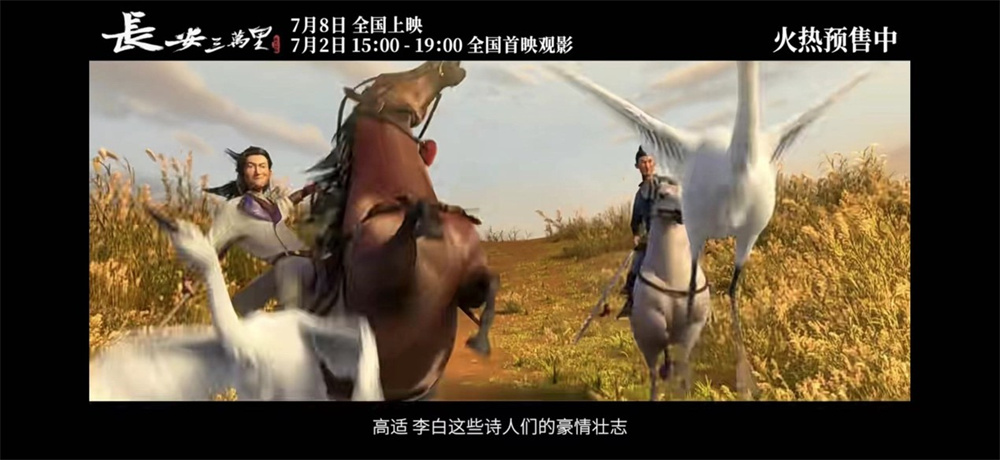
Li Bai and Gao Shi
The surreal presentation of Li Bai's creation "Will Enter the Wine" in the film is the deepest memory of many audiences for this film. The exiled immortal rode a crane to the Lingxiao Palace, and exchanged cups with the gods in the sky. From storyboarding and design to animation performance, to special effects, and even dubbing, every link of this scene is full of challenges. As one of Li Bai's most famous poems, the poems are full of emotion and unrestrained. What kind of visual presentation is worthy of this poem? The creative team has made many attempts, and only "the water from the Yellow River comes up from the sky" has made many versions. Since this scene is completed in the voice of Li Bai reciting poems, there is a high requirement for the harmony of lines, music, and pictures, which is a test of visual imagination. The scene of "Will Entering Wine" was put on the agenda from the very beginning, and the production of just one shot took half a year. The production cycle of the entire project is three years, and the production time span of "Will Entering Wine" is nearly two years.

Surreal presentation of the artistic conception of "Will Enter the Wine"
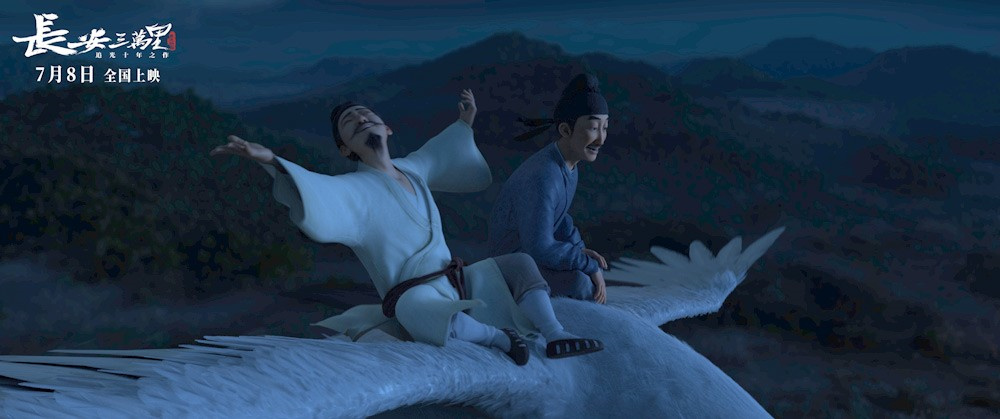
Li Bai rides a crane and recites "Will Enter the Wine"
In terms of grasping details such as modeling, scenes, props, and performances, "Three Thousand Miles of Chang'an" tried its best to restore the style of the Tang Dynasty, trying to draw the audience into the prosperous Tang Dynasty. For example, among the many etiquettes in the Tang Dynasty, there was one called the Chashou ceremony, which could represent many different meanings. Most of the intervening ceremony in the movie is to show respect, but in one of the scenes where the man in black chases and kills Li Bai, Guo Ziyi saves the two. The man in black also uses an intervening ceremony to face Guo Ziyi, but this intervening ceremony is The opposing sides are expressing disdain. There are many wonderful and moving literary dramas in movies. Compared with action dramas, literary dramas have higher requirements for performance, and they also test the accuracy of animation and performance skills.
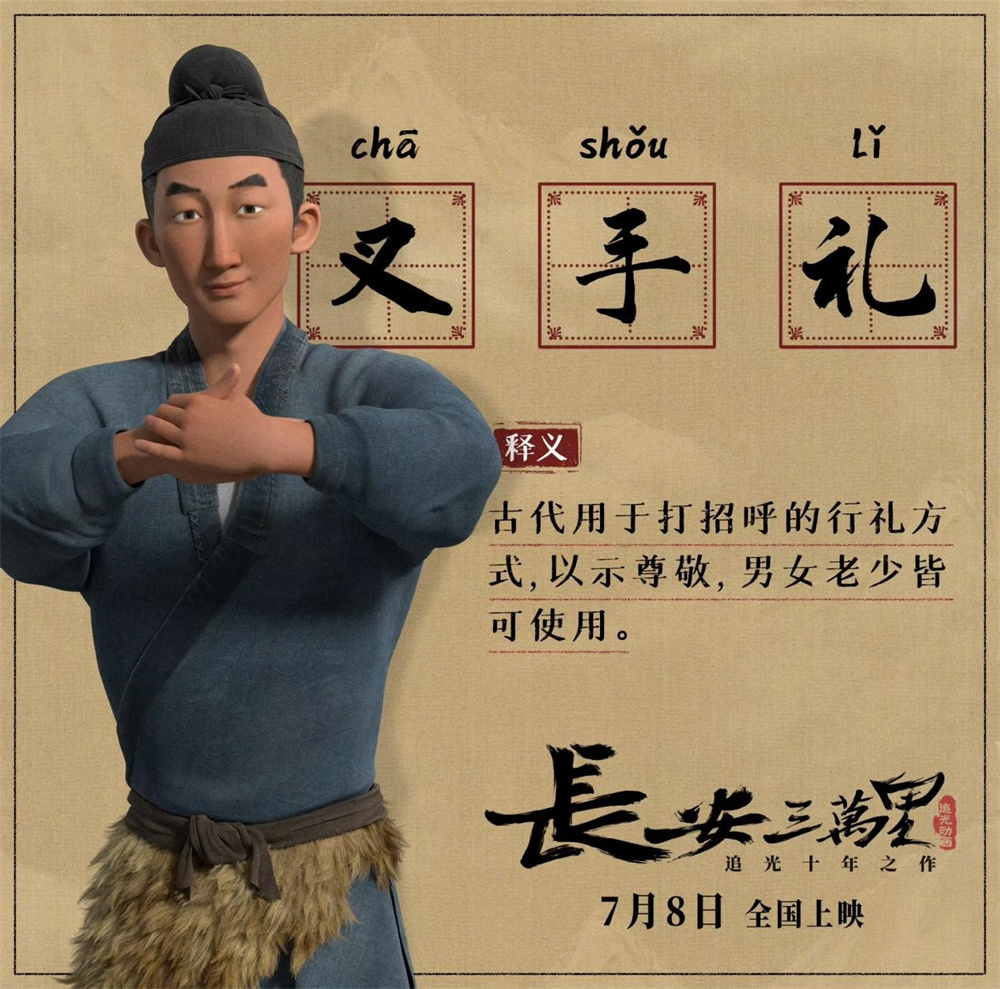
cross hands ceremony
The design of most of the props in the film has also been researched. In addition to the general written records and picture references, the project team also specially hired an etiquette teacher, and some props will also ask for his opinions. In the movie, there is a scene where Li Bai buries Guidance Wu. There is wormwood beside the tomb, and Li Bai pours rice wine on it. This design originated from a traditional custom at that time. The etiquette teacher found relevant information and found that it was rarely shown in previous film and television dramas. In addition, there are poem boards on the Yellow Crane Tower for literati to inscribe poems, screen walls outside the county guard's mansion, musical instruments used by ethnic minorities, ornaments worn by Princess Yuzhen, crops planted in Liangyuan, Gao Shi's journey to Chang'an City, etc. The greeting card, the tomb of Gao Shi’s grandfather, and the wine raising game among literati played by Li Bai and others in the Qujiang restaurant are all imagined and restored by the crew based on historical materials such as documentaries and unearthed cultural relics.
In terms of soundtrack, according to two different themes in the film: one is the relentless pursuit of ideals, and the other is the friendship between Gao Shi, Li Bai and others, these two lines correspond to two music melodies in the film, and use Many traditional Chinese musical instruments are very oriental. The theme music of the film is repeated at several important moments related to the theme, intending to let the audience feel the connection between events and the emotional connection of characters through the same melody.

Inside Chang'an City
When introducing the production difficulties, the main creative team mentioned that the most difficult thing about this film is not the technology, but how to restore the magnificent scenery of the Tang Dynasty, how to show the artistic conception of poetry, how to show the freehand feeling of ancient paintings, and how to make everyone feel that ancient paintings are moving.
The beginning of the "New Culture" series, looking for "romance unique to Chinese people"
Since its establishment in 2013, light-following animations have been based on folk myths and legends familiar to the people. Light-following animations such as "Little Door God", "White Snake: Origin", "New God List: Nezha Rebirth", "White Snake 2: Green Snake Tribulation", " Excellent domestic animation films such as "New God List: Yang Jian", with gorgeous and delicate visual effects, create exquisite animation films for the Chinese film market with quality comparable to Hollywood. The "New Legend" series based on "White Snake: Origin" and "White Snake 2: The Green Snake" and the "New Mythology" based on "New God List: Nezha Rebirth" and "New God List: Yang Jian" The series have their own characteristics, covering the preferences of the vast number of young audiences, and are deeply loved and supported by Guoman fans. The basic character setting and story style in the movie follow the spirit of the original work, Xu Xian White Snake who is not accepted by the world, Green Snake who dares to love and hate, Nezha who is born rebellious, Yang Jian who is lonely and brave, Chen Xiang who protects family, these classics After the newly edited characters in myths and legends, they convey the same pure and more contagious spiritual power to contemporary movie audiences.
"Three Thousand Miles of Chang'an" opens a new chapter in the "New Culture" series of light-following animation. Family audiences tell the stories of these shining characters.
Compared with the legends that are familiar to the audience with gorgeous and fantastic animations, the "New Culture" series intends to find things that are familiar and unfamiliar to the audience. Taking "Three Thousand Miles of Chang'an" as an example, there are many audiences who are familiar with Li Bai and Gao Shi's poems, but their stories are both familiar and unfamiliar to the audience. Therefore, "new culture" is actually a reinterpretation of traditional culture, showing many stories that the public may not know well. The "New Culture" series also refers to interpreting traditional culture from a new perspective and presenting traditional culture in a new way. Through the form of animated films, audiences can experience the magnificent scenery of the Tang Dynasty, the poet's lofty ambitions, and the charm of Tang poetry that have been passed down for thousands of years in "Three Thousand Miles of Chang'an", and taste the "romantic unique to the Chinese".
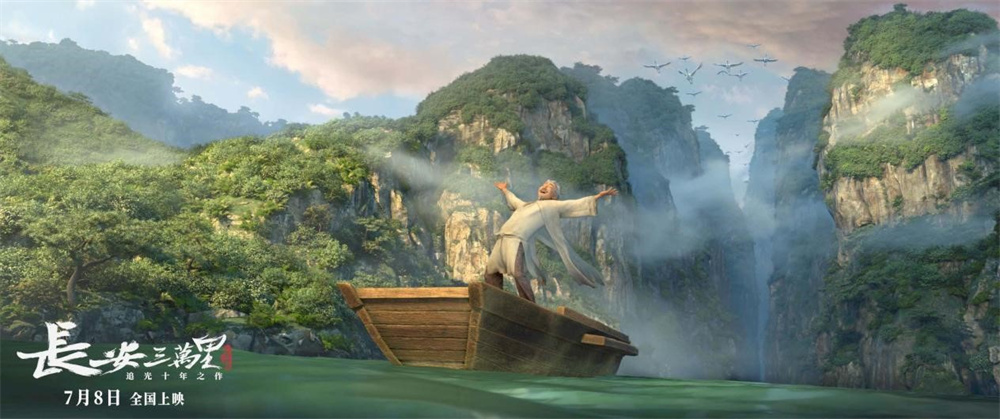
"Chaoci Baidi Caiyunjian"
Through "Three Thousand Miles of Chang'an", the audience can feel that history and culture are three-dimensional, not just a certain picture or a certain poem in a textbook, but it carries many spirits and stories. Li Bai, Gao Shi, Du Fu, Meng Haoran, Wang Wei and other great poets more than a thousand years ago were also in their prime, growing up all the way, pursuing their ideals and earning fame in the magnificent Tang Dynasty. And they are also fresh people like us today, who will encounter setbacks and feel lost. The film allows the audience to see the emotions and stories of the poets who created these famous lines through the ages.
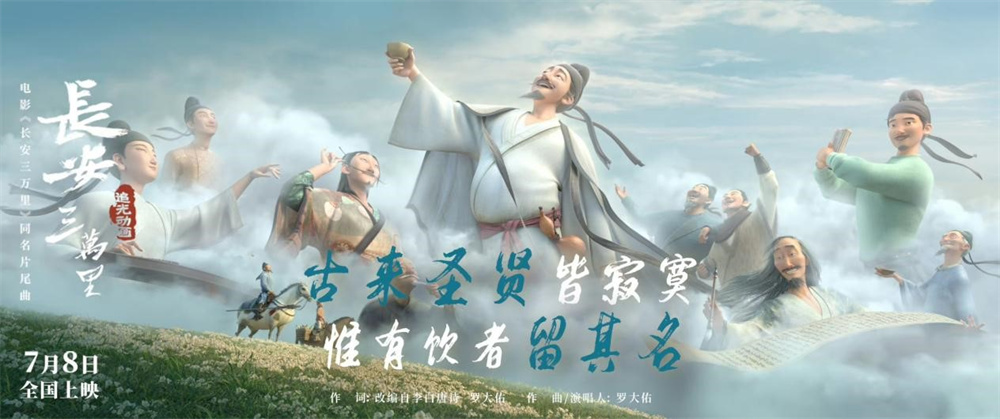
Stars of the Tang Dynasty
Although it is the first time for Xie Junwei to be a director, as an "old man" who has joined since the establishment of Light Chasing Animation in 2013, in the 10 years of chasing Light, he deeply feels that he has reached a certain resonance with these poets in their pursuit of ideals. "Ten years of chasing light, those of us who follow light still hope to tell Chinese stories, and we believe that it will definitely impress some people. I feel very happy, because the ideals we pursue and the works we create are in harmony with each other."
At the preview of "Thirty Thousand Miles of Chang'an", another director, Zou Jing, was sitting with the audience in a dark theater. moved. At that moment, Zou Jing felt that film, as a medium, conveys human emotions and connects each other. This connection transcends time and space, which is the greatness of film.
"There will be many practical difficulties throughout the creative process, and everyday things are very complicated. But when I think that the film I am creating is about Li Bai, Gao Shi, about the Tang Dynasty and poetry. I suddenly feel that there is no It’s difficult. I want to make the movie and the story a good one. These characters are real historical figures, and I have a responsibility to them.” Zou Jing said.

Producer Song Yiyi


